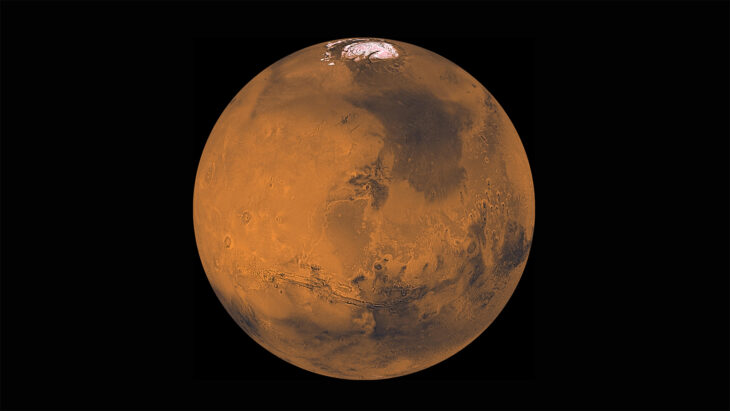Water is essential for life, so when researchers want to explore another planet, they first locate its water resources. Astrobiologists are particularly interested in Mars due to its evidence of past water, which could have enabled life. Since the surface of Mars is cold and dry today, they want to know where that past water went. Scientists have shown that Mars has an active water cycle that forms water ice clouds, but they don’t know whether water exists on the planet’s surface.
Recently, an international team of researchers used high-resolution images and spectral light analysis to look for frost on Martian volcanoes. The researchers examined roughly 4,200 images from an observational imaging technology called Colour and Stereo Surface Imaging Technology, or CaSSIS. This technology uses satellite images of the Martian surface from the European Space Agency’s Trace Gas Orbiter. They explained that frosty surfaces reflect brighter at blue wavelengths in spectral light, so they mapped frost by looking for blue-colored wavelengths in the CaSSIS data.
Based on these analyses, the team found 13 areas of frost on 4 Martian volcanoes, including Olympus Mons, Ceraunius Tholus, Ascraeus, and Arsia Montes. The researchers looked at images taken over 12 hours and saw a large accumulation of frost on the rim and crater of Olympus Mons in the early morning. On this single crater, the frost covered an area of roughly 4,500 kilometers or 3,000 miles, about the size of Philadelphia. The researchers estimated that these deposits were extremely thin, roughly 10 microns thick, or about one-tenth the width of a human hair.
Next, the researchers wanted to determine if the frost was made of water or carbon dioxide. They explained that Mars’ atmosphere is made up almost entirely of carbon dioxide gas, and carbon dioxide can freeze. Like Earth, Mars has ice on its polar regions, but Martian polar ice caps contain mainly carbon dioxide and small amounts of water. So they reasoned that the volcano frost could similarly contain frozen carbon dioxide.
The team used the Mars Weather Research and Forecast model to calculate the surface temperatures of Martian volcanoes over 24 hours. They found the minimum temperatures were -190°F, or about -120°C. They explained that carbon dioxide frost forms at surface temperatures lower than -200°F or -130°C, so these temperatures were too warm for carbon dioxide frost to form. However, since water frost forms in Mars’s atmosphere at around -140°F or -95°C, they proposed that the volcano frost deposits were made of water.
The researchers pointed out that these Martian volcanoes are some of the highest-altitude volcanoes in our solar system, but they’re also located within Mars’ equatorial region. Normally, they would not expect water ice to form on volcanoes in a tropical region because their slopes and flanks would be too warm for frost to condense. However, their climate models demonstrated that the topography of these volcanic craters created localized weather patterns that allowed frost to form.
Finally, the researchers performed additional observations and climate model simulations of Olympus and Arsia Mons to test whether this frost could form during the day or only at night. They found that frost accumulated in the early Martian morning during the winter and spring on both volcanoes, but not during the summer. Although they only looked at potential seasonality on Olympus and Arsia, they suggested these patterns could indicate seasonal temperature fluctuations on Mars.
The researchers concluded that Martian volcanoes produce an average of 150,000 tons or 150,000,000 kilograms of water frost daily. They proposed that Martian water frost most likely forms due to seasonal trends in atmospheric phenomena like wind patterns and atmospheric pressure. They suggested that studying these processes could help scientists determine whether life could be sustained on Mars. On the other hand, they stated that further research is needed to rule out a direct volcanic source for the water.
For another take on this article, see the summary by Trinity geology student Meredith Brashear.


